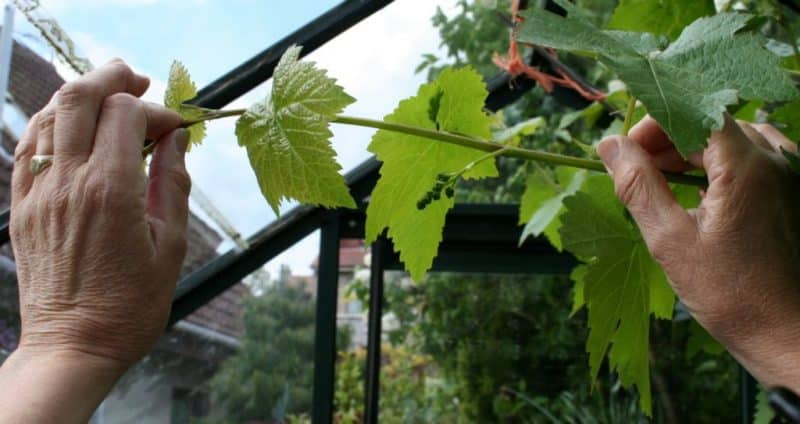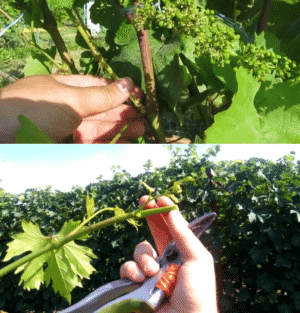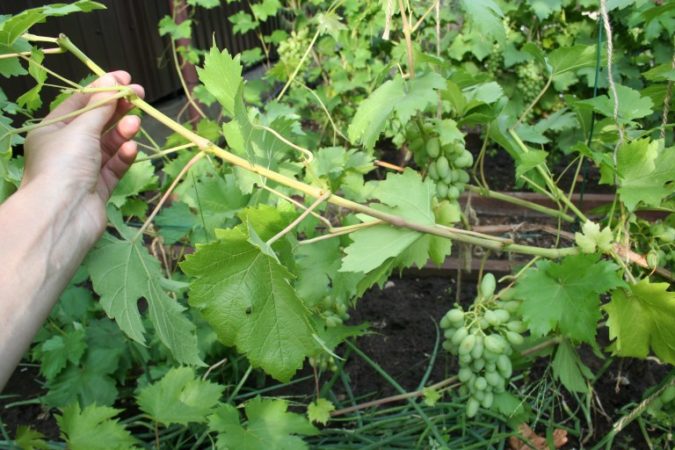How to properly prune green young shoots of grapes in summer: diagram and step-by-step instructions
The main pruning operations of the vine are carried out in early spring and late autumn, but the bush is formed throughout the summer. To do this, remove excess shoots. The procedure is safe for the plant and has a positive effect on yield, especially in the middle zone.
Let's look at how to properly trim green young shoots of grapes in the summer and what patterns to follow.
Why prune young green shoots in summer?

Grapes have a high ability to form shoots. If you do not control it, the bush will grow, and it will not have the strength to form a crop.
Goals
Basic goals trimmings - judicious use of nutrients and maintaining plant health.
Reasons why it is necessary to carry out summer pruning:
- nutrition is directed to the parts of the bush responsible for the formation of the crop and its growth;
- a properly formed bush looks neater and is easy to look after care;
- a thinned bush receives more light and air, which reduces the risk of diseases caused by fungus;
- When berries receive a large amount of light, they retain more nutrients and ripen faster.
If you want to get a large harvest of tasty berries, summer pruning is mandatory. It helps the plant to evenly distribute the load and receive the maximum amount of nutrients.
Duration of the procedure
Pruning is carried out several times during the summer at different stages of crop growth:
- When the first buds bloom, it becomes clear which shoots will not bear fruit - they are disposed of first.
- In mid-summer, shoots with clusters slightly higher than the one they decide to leave are pinched. 1-2 clusters are left on each vine. More is permissible only for some technical varieties: for example, Odessa Muscat or Crystal.
- Pruning is carried out all summer, after flowering. New stepsons are removed every week already at the stage of their appearance.
- At the beginning of August, chasing is carried out: a significant part of the already grown but unnecessary shoot is removed with pruning shears.
- 2 weeks before harvesting, the bush is lightened by removing a large number of leaves, which block access to sunlight to the bunches.
The exact timing of the procedures depends on climatic conditions.
Trimming scheme

The formation of the bush occurs during the first 3-4 years. There are 2 pruning schemes: standardless and standard.
First optimal for cold climates when the vines are covered for the winter. Sleeves that are more than 2 years old are laid on the ground. With this type of formation, it is better to leave a limited number of sleeves that will extend in different directions. As a result, the bush is left with 4 strong shoots.
When standard pruning in the first year, a stake 1.5 m high is dug next to the vineyard. When the central stem grows 60 cm, its top is pinched. In the autumn of the first year they knock together trellis and stretch the wire with an indentation of 1 m.
In autumn, the central shoot is cut to the level of the trunk, and the rest are broken off at the base. This pruning is carried out in warm climates. As they grow, useful vines are tied to a trellis and the top is pinched off.The procedure increases the yield level by 40%, but it is recommended to apply it only to tall varieties.
How to trim green shoots in summer
Pruning of unnecessary green shoots is carried out in several stages:
- pinching;
- stepsoning;
- minting;
- lightening.
In some varieties capable of peas, at the final stage the bunches are “combed” - berries that are too small are removed.
Removing shoots
Throughout the summer, the grapes are regularly inspected and “empty” shoots are removed. First of all, this concerns the growth near the roots. It provides excessive shade and draws a huge amount of nutrients from the bush, preventing it from forming a high-quality harvest.
Pinching
Pinching is carried out almost before flowering. Use your hands to remove the very top of the vine with the leaves still closed. The optimal distance is 10 cm from the first inflorescence.
Important! The result of the procedure lasts for 2 weeks, after which it is repeated.
With the help of pinching, it is possible to reduce the growth of side shoots and increase the formation of flower ovaries.
Stepsoning
During the period of active summer growth, many lateral branches are formed, which are located between the shoot and the green mass.
Above the first leaf at the base, all the stepsons are cut off, leaving small stumps 2 cm in size. All tendrils are cut out if the vine itself is tied to a support. During the procedure, the plant is inspected and tied up. Frequency: once every 7 days.
Coinage
The principle of operation is the same as in pinching, but most of the top is captured, up to 40 cm, in some fast-growing varieties - up to 1 m. The procedure can be carried out manually, but it is better to use a disinfected sharp knife or pruning shears.
They begin to mint when the top of the shoot is completely straightened and about 9 leaves are open. For normal fruiting on the vine, it is enough to leave 14-15 leaves.
Lightening
Lightening is the thinning of the leaf mass in order to improve the flow of sunlight to the grape bunches. To do this, cut off the old foliage and up to 5–7 leaves on the crown. The procedure is carried out at the moment of tying the bunches.
It is important to remove all foliage torn from the grapes outside the site. If you leave it under the bush, pathogenic bacteria will multiply in it and affect all the grapes.
Features of green pruning for young and old grapes

The principles, timing and goals of green pruning for young and old grapes are not particularly different.
The difference is noticeable in autumn pruning, when the leaves have already fallen. In an old bush, it is important to identify non-viable shoots and remove them. To do this, just cut off a small part of the stem and look at the cut. If it is green, the shoot is alive.
Post-procedure care
Trimming green shoots does not damage the grapes too much, so care remains standard:
- watering at the rate of a bucket of water per plant;
- introduction of basic fertilizers: ammonium nitrate, ammonium sulfate;
- loosening and mulching of the root area;
- tying the vine to a support.
Be sure to inspect and protect the plant from pests and diseases. Young green shoots can be removed manually, but so that the area of damage is minimal.
When used, pruners or scissors are treated with any alcohol-containing solution.
Conclusion
Removing green shoots in summer is an important procedure that preserves the health of the grapes and increases yield.
It is carried out in several stages, starting with the removal of young shoots and ending with the clarification of the vineyard with the clusters set. This is done manually or using garden tools. The frequency of pruning is once every 1-2 weeks.